Summary
This page discusses the tiny animals and other microorganisms who are brought into existence by sewage treatment.
Contents
Introduction
Aquatic microorganisms are born without their consent into short lives that soon end with (possibly) painful deaths. One source of food for microorganisms is human wastewater, which contains, inter alia, excrement and, in some cases, ground-up food scraps.
There are many types of wastewater-treatment systems, and I'll only discuss a few common ones here.
The type of wastewater system that your home water goes to depends on where you live. Often you can look up general information about your sewage-treatment facility online, by searching something like {albany ny sewage treatment plant}.
Septic system
Many residents of rural areas use onsite sewage facilities, most commonly septic systems. For more on this type of wastewater treatment, see "Microorganisms Created by Septic Systems".
Activated sludge
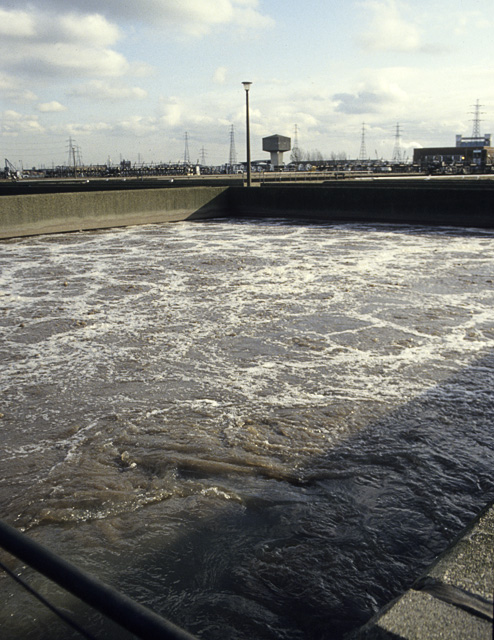 The activated-sludge process is a common type of large-scale secondary wastewater treatment.
The activated-sludge process is a common type of large-scale secondary wastewater treatment.
National Small Flows Clearinghouse (2003) says (pp. 1-2):
The activated sludge plant is the most popular biological treatment process for larger installations or small package plants being used today. [...]
The activated sludge process is widely used by large cities and communities where large volumes of wastewater must be highly treated economically. Activated sludge process plants are good choices too for isolated facilities, such as hospitals or hotels, cluster situations, subdivisions, and small communities.
New York City's wastewater system uses an activated-sludge design. NYC DEP (n.d.): "Secondary treatment is called the activated sludge process. [...] Air pumped into large aeration tanks mixes the wastewater and sludge that stimulates the growth of oxygen-using bacteria and other tiny organisms that are naturally present in the sewage."
Huler (2010) reports that an "activated sludge process" is used by "The Neuse River Wastewater Treatment Plant, southeast of Raleigh", North Carolina, USA.
Activated-sludge microorganisms
Wikipedia ("Activated sludge") says that the biological floc in activated-sludge systems "is largely composed of saprotrophic bacteria but also has an important protozoan flora component mainly composed of amoebae, Spirotrichs, Peritrichs including Vorticellids and a range of other filter-feeding species. Other important constituents include motile and sedentary Rotifers."
Madoni (2010), p. 4: "free-living protozoa[...] are commonly found in the mixed liquor of activated-sludge plants and numbers of the order of 3–20 × 106 cells l–1 are often reported. It has been estimated that the protozoa biomass can reach values of 250 mg l–1 (dry weight)".
Glymph (2013) says (p. 138) that "Metazoa dominate in longer age systems including lagoon treatment systems." Theobald (2014) concurs: "Metazoa-Dominate longer age systems including lagoons". And Seman (n.d.) says (p. 58): "Dominance of metazoa indicates OLD sludge". I'm not sure what "dominate" means here. Surely it doesn't mean numbers of individual organisms. I'm not even sure it means biomass? Maybe it just means there are a lot more metazoa than normal? For more on lagoons, see the "Lagoons" section of this piece below.
As is well known, most animals require oxygen to live.a Maine Lagoon Task Force (2003) reports that the same is true for protozoa: "Protozoa are strict aerobes." So anaerobic conditions largely rule out both protozoa and metazoa. Glymph (n.d.) concurs (p. 13): "protozoa must have oxygen to survive. Lack of oxygen will severely limit the kind and number of protozoa present." However, Theobald (2014) claims that some protozoa can survive without oxygen: "some protozoa need oxygen, some require very little oxygen, and a few can survive without oxygen."
Myers (2011) says at 3m20s: "Both nematodes and rotifers can be indicative of an older bacterial biomass and in wastewater are indicative of a higher degree of purification or seeding from an attached-growth system." Does the last statement of this quote imply that nematodes and rotifers are more plentiful in attached-growth wastewater-treatment systems (discussed later in this piece), so that sludge taken from those systems for seeding contains more such organisms than suspended-growth treatment systems typically do??
Wisconsin Department of Natural Resources (2010) notes (pp. 1-2) that "As activated sludge gets older, more stalked ciliates and rotifers will be commonly seen. If the sludge gets too old, rotifers and nematodes will dominate." It illustrates this point with the following figure (p. 4):
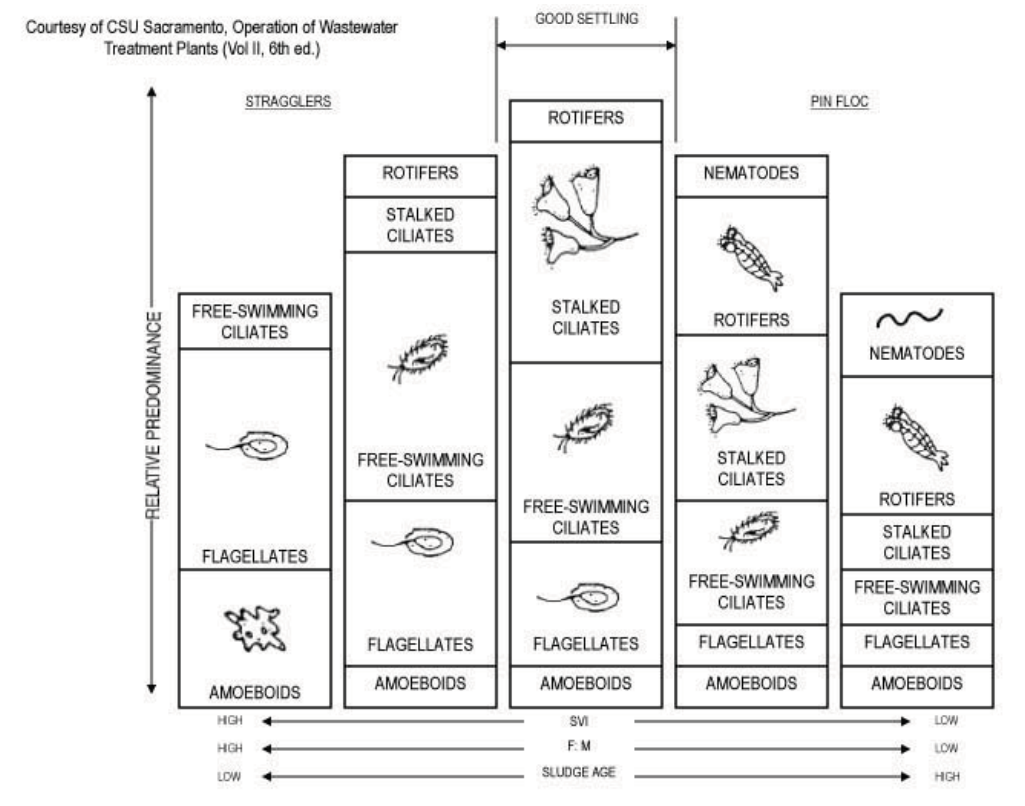
Microorganism composition
National Small Flows Clearinghouse (2003), p. 3:
Activated sludge consists of a mixed community of microorganisms, approximately 95 percent bacteria and 5 percent higher organisms (protozoa, rotifers, and higher forms of invertebrates). [...]
The most predominant microorganisms are aerobic bacteria, but there are also substantial populations of fungi and protozoa. Rotifers and nematodes are most frequently found in systems with long aeration periods.
Seman (n.d.) reports (p. 36) that protozoa "Make up about 3 percent of activated sludge microorganisms".
Glymph (2013) gives a breakdown by organism type in activated sludge (p. 25):
Bacteria (95%)
Protozoa (4%)
Metazoa (1%)
None of these sources specifies what measure these percentages are using, but I would guess it's mass rather than raw number of organisms? To see this, consider that bacteria are typically 0.5 to 5 micrometers, while rotifers are typically 0.1 to 0.5 millimeters. Even if we conservatively assume a bacterium is 5 micrometers and a rotifer is 0.1 millimeter = 100 micrometers, that implies a difference in volume and mass of roughly (100/5)3 = ~104. So if 1% of all the individual organisms in wastewater were rotifers and 95% were bacteria, rotifers would outnumber bacteria in mass by 104 * 0.01 / 0.95 = ~100 times. But this is clearly not the case, as you can see in helpful videos like this and this. Madoni (2010) confirms (p. 3) that bacteria preponderate even in terms of mass: "The organisms most directly involved in wastewater treatment are the bacteria. They dominate all other groups, in number and biomass".
My impression is that many protozoa are closer in size to metazoa than to bacteria.b For example, Vorticella has a "bell" up to 0.15 mm and a stalk up to 1 mm in length. Arcella has a shell up to 0.3 mm in diameter. Chilodonella is 0.1 to 0.15 mm. And so on. Because of this closeness in size between protozoa and metazoa, I assume that the following table, taken from p. 2 of Wisconsin Department of Natural Resources (2010), actually does represent counts rather than biomass:
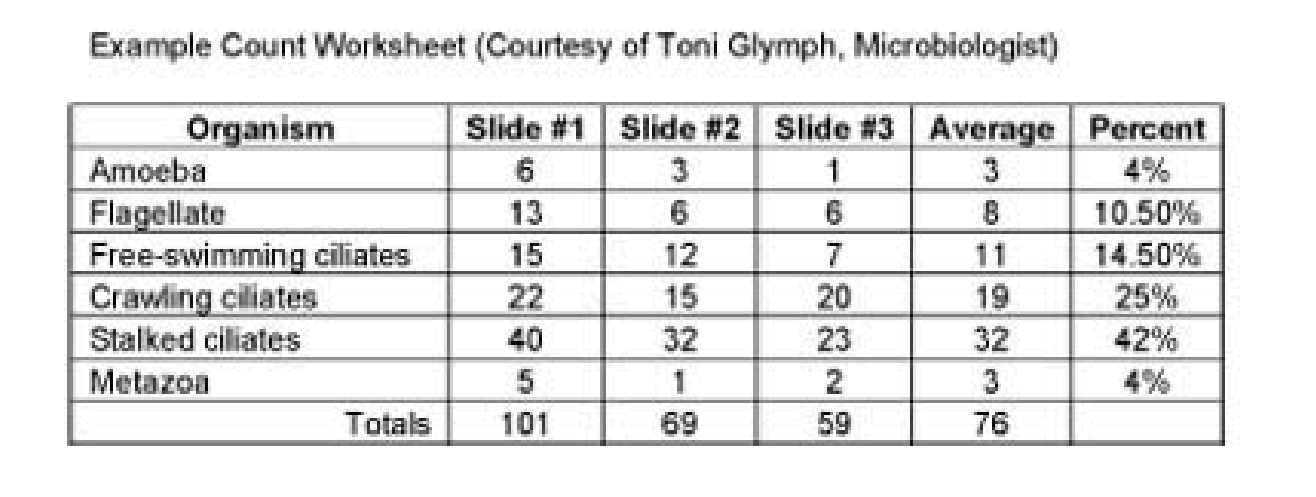
I emailed Toni Glymph-Martin to ask whether statements like "95% of the microorganisms in activated sludge are bacteria" and "4% are Protozoa" (Glymph n.d., p. 9) refer to numbers of individual cells or mass. Glymph-Martin replied: "They are more by number and mass. The percentage [of bacteria] can range from 95-99%" (personal communication, 25 Sep. 2017, quoted with permission).
Comparison with compost
If ~1% of activated-sludge heterotrophic biomass is metazoa (rotifers, nematodes, tardigrades, etc.), how does this compare to a compost bin, which is another potential way to dispose of food waste? The "Brady (1974)" table in Tomasik ("Abundances ...") shows that, e.g., nematode biomass is 10 to 100, while bacteria biomass is 400 to 4000.c Just considering these two types of life forms, nematodes constitute about 10/(10 + 400) = 100/(100 + 4000) = ~2% of biomass, which is similar as in activated sludge. However, soil also contains a significant earthworm biomass (about 25% as high as bacterial biomass). I wonder if this is because earthworms live longer than micro-animals do, so they accumulate more standing biomass? I'm not aware of any earthworm-like animals in activated sludge that have long lifespans and high biomass.d So the percent of biomass consisting of metazoa is plausibly higher in soil/compost than in activated sludge.
That said, metabolic rate might be a better metric for moral relevance than mere standing biomass. I don't know how metabolic rate compares among bacteria, nematodes, and earthworms, though I would conjecture that larger organisms have lower metabolic rates per unit biomass, as per Kleiber's law. In this case, the high total biomass of earthworms in soil relative to the total biomass of smaller animals may not imply a correspondingly high total metabolic rate relative to smaller animals?
Sentience
Metazoa (animals) are in my opinion the most sentient wastewater organisms per unit of metabolism, but this is debatable, and I'm uncertain how I feel about the sentience of protozoa. Metazoa, unlike protozoa, have nervous systems.
Glymph (n.d.) explains that while many protozoa eat bacteria, some protozoa eat other protozoa (p. 12):
If the sludge continues to age (usually too old), and with no food or bacteria left to feed on, protozoa-eating protozoa begin to dominate. The suctorian is so named because it has “suckers” or tentacles extending from its head. The suctorian will wait for an unsuspecting protozoan and will suck it into its tentacles, secrete a toxin to paralyze it and will begin to suck the body juices out.
I'm curious whether this process is painful for the prey organism. Does the prey organism struggle to escape? Does its body engage internal stress reactions?
Serpil Demir (2016) shows the suctorian Podophrya capturing a prey organism (at 1m13s), which visibly struggles to escape for about 1.5 minutes (until around ~2m45s). I assume the prey organism is probably undergoing some internal physiological changes during this process, though I don't know what they are or how much they match our conception of "(rudimentary) suffering".
Of course, some metazoa also eat protozoa. For example, Glymph (n.d.) explains (pp. 14, 16):
Nematodes may be seen in significant amounts in longer aged systems or older sludges. They do not contribute to the overall treatment and feed on bacteria, protozoa, fungus and sometimes they eat other nematodes. Some nematodes have teeth and some have a spear they can stick into their prey and then use the spear to suck in food like a straw. [...]
Water bears [...] have a head with eyes and a mouth that they use to pierce their food before sucking out the inner parts. [...]
stalked ciliates and metazoa will be predominant in longer age systems mainly because of their ability to compete when very little nutrients are left and their ability to feed on other protozoa.
Land covered by treatment works is probably negligible
One minor upside of activated-sludge treatment is that the treatment buildings and other structures cover over land and prevent vegetation growth on it. Preventing vegetation growth reduces food and habitat for soil critters and thus prevents some invertebrates from being born. However, relative to the volumes of organic matter processed by a wastewater plant, prevented vegetation growth is negligible, as the following calculation shows.
Diggelman and Ham (2003) report (Table 2, p. 505, "POTW" column) that disposing of 100 kg of wet food waste down the drain is responsible for 2.4 * 10-4 m2 of land use due to wastewater infrastructure.e I'm not sure if vegetation is prevented on all of this land area, since wastewater-treatment plants can have grass between the different buildings, but let's conservatively assume that vegetation is prevented on this entire land area. Since a wastewater-treatment plant is designed to last 30 years (p. 507), this is actually (2.4 * 10-4 m2) * (30 years) = 7 * 10-3 m2-years of land use, which I'll round to 10-2 for convenience.
Net primary productivity on most types of land tends to be on the order of ~103 g per m2-year (Tomasik "Net ..."). So the land area covered by sending 100 kg of food waste down the drain would have produced roughly (10-2 m2-years) * (103 g per m2-year) = ~10 g of vegetation. Obviously, the decomposition processes for the 100 kg = 100,000 g of food waste being sent down the drain are far more consequential for invertebrate suffering than the prevention of ~10 g of vegetation.
Attached-growth systems
Filter beds
Wikipedia ("Secondary treatment"):
Biofilms of bacteria, protozoa and fungi form on the media’s surfaces and eat or otherwise reduce the organic content. The filter removes a small percentage of the suspended organic matter, while the majority of the organic matter supports microorganism reproduction and cell growth from the biological oxidation and nitrification taking place in the filter. With this aerobic oxidation and nitrification, the organic solids are converted into biofilm grazed by insect larvae, snails, and worms which help maintain an optimal thickness.
Wikipedia ("Trickling filter"): "The bio-film that develops in a trickling filter may become several millimetres thick and is typically a gelatinous matrix that contains many species of bacteria, cilliates and amoeboid protozoa, annelids, round worms and insect larvae and many other micro fauna."
While I don't have concrete numbers, the above descriptions make me think that trickling filters probably support more invertebrates than activated-sludge systems per unit of incoming organic matter? Or maybe trickling filters just support larger-sized invertebrates like fly larvae and snails, while activated-sludge systems still have plenty of smaller-sized rotifers and nematodes?
Madoni (2010) says regarding percolating filters (which I assume are the same as trickling filters?), p. 4: "Ciliophora is the phylum of protozoa that contributes the greatest number of individuals to the microfauna of a percolating filter. Ciliates range from 500 to 10,000 individuals per ml of liquor". This is 5 x 105 to 107 per liter, which seems comparable to the "3–20 × 106 cells l–1" mentioned above for free-living protozoa in activated-sludge systems.
Sarai (1975)
Sarai (1975), pp. 238-39:
The [trickling] filter supports a complex community of microorganisms like bacteria, algae, fungi, protozoa, and rotifers, and grazers like snails and insect larvae. [...] Fly larvae are found throughout the filter bed. Adult flies rest on filter walls and nearby buildings. They are a nuisance for plant workers and people in the neighborhood. Plant operators use various methods to control them [...].
Apparently, under normal loadings, normal insect populations (ca. 100 larvae/ 100 cm2) are helpful in filter efficiency by preventing clogging and permitting vigorous bacterial growth through grazing activity. Over organic loading causes higher insect populations resulting in a nuisance and reduced efficiency due to less zoogleal film and more solids contributed by larvae.
It's not completely clear to me what kind of measurement is meant by "100 cm2" of surface area, but Sarai (1975) discusses "rock surface area" (p. 238), so I'm guessing it refers to the actual surface area of individual rocks (rather than just the surface area of the top of an imaginary vertical cylinder extending downward from the filter's surface).
Sarai (1975) examined three different "trickling filter sewage treatment plants" that had different densities of fly larvae (p. 238). Describing the filter with the most fly larvae, Sarai (1975) reports (pp. 238-39) that the "filter had a very high density of psychodid larvae below a 6-in. depth [...], with maximum density at 18 in. where some rocks were practically covered with larvae. Larval density declined below 24 inches. Pupae were found at all depths and more commonly below 18 inches. Adults were mainly sitting on walls and some in the spaces within the filter media."
Rotating biological contactors
Wikipedia ("Secondary treatment"): "The rotating disks support the growth of bacteria and micro-organisms present in the sewage, which break down and stabilize organic pollutants."
Madoni (2010), p. 4: "The quantitative importance of protozoa in [rotating biological contactor] systems has been determined in terms of biomass [...]: a ciliate biomass value of 314 μg cm–2 (dry weight) has been measured".
Bacterial response to variable food
Westerling (2014) describes different eating behavior of bacteria in attached-growth systems compared against suspended-growth systems like activated sludge:
According to Denn, suspended-growth technologies often struggle with highly variable waste streams. “The bugs [i.e., bacteria] get used to eating a certain amount of food, and when that food is taken away, they look at each other as food,” he explains. “They're all in contact with each other, so they start cannibalizing and reducing your total number of organisms.”
“With attached-growth,” he continues, “they don't go hunting down other bugs. When the food reduces, they basically learn to eat less, just like you or I would. If we're used to eating a lot, but for some reason we couldn't afford to eat as much as we did, we would learn to survive on less food. It's the same thing.”
Presumably the total amount of bacterial suffering differs between these two approaches, though it's not obvious which one is better.
Vermifilters
Possibly the worst form of waste treatment I've seen from the perspective of invertebrate suffering is vermifilters, which use bacteria and earthworms to decompose organic matter from wastewater. Wikipedia ("Vermifilter") reports: "Vermifilters are most commonly used for sewage treatment (either at a centralized level or in an on-site sewage treatment facility) and for agro-industrial wastewater treatment." Fortunately, my impression is that these systems aren't too common??
Composting toilet
Wikipedia ("Aerobic ...") says regarding the Clivus Multrum composting toilet: "Within the chamber, the urine and feces are independently broken down not only by aerobic bacteria, but also by fungi, arthropods, and earthworms."
Lagoons
Wikipedia ("Sewage treatment"): "Lagoons or ponds provide settlement and further biological improvement through storage in large man-made ponds or lagoons. These lagoons are highly aerobic and colonization by native macrophytes, especially reeds, is often encouraged. Small filter-feeding invertebrates such as Daphnia and species of Rotifera greatly assist in treatment by removing fine particulates."
As of 1980, approximately 7,000 waste stabilization lagoons were in use in the U.S. Today, one third of all secondary wastewater treatment facilities include a pond system of one type or another. Of these, just over 90% are for flows 1 [million gallons per day] or less. But ponds can be used for larger cities for wastewater treatment as well. Some of the largest pond systems in this country are in Northern California, serving such cities as Sunnyvale (pop. 105,000), Modesto (pop. 150,000), Napa (pop. 175,000), and Stockton (pop. 275,000).
Maine Lagoon Task Force (2003):
Lagoons and ponds are similar to activated sludge systems in function, however, the mass of biological solids is much less. [...] Lagoons and ponds function 10-20 times slower than activated sludge systems because they have less biomass. [...] Bacteria are responsible for the majority of the activity in a lagoon system. [...] Rotifers and nematodes (worms) are animals found in lagoon systems.
It's worth keeping in mind that not all the heterotrophic productivity of lagoons comes from wastewater decomposition. These lagoons can also grow algae like ordinary ponds do, and some of that productivity would occur in a natural pond without external inputs of organic matter. Of course, the influent nutrients can increase productivity, thereby increasing invertebrate suffering relative to what would occur in a natural pond? Wikipedia ("Facultative lagoon"): "Wastewater nutrients may cause continuing growth of algae in the polishing ponds after the original wastes have been catabolized." In other words, wastewater may both directly feed heterotrophs via the organic matter it contains and indirectly feed heterotrophs because the incoming nutrients stimulate more algae growth.
Tomasik ("Zooplankton Created ...") does rough calculations of the numbers of zooplankton created by two "facultative aerated wastewater treatment lagoons" in upstate New York.
Maine Lagoon Task Force (2003) notes: "Freely dispersed, floc-forming and filamentous bacteria, similar to those found in activated sludge systems, are found in lagoons and ponds. Many of the bacteria found in ponds are motile." This fact might have a smidgen of moral relevance if we think that a motile bacterium is, other things equal, more sentient than a non-motile bacterium, perhaps because the motile bacterium has to be able to navigate?
Stabilization ponds
Babu (2011)
Babu (2011) reports (p. 3): "Wastewater stabilization ponds (WSP) are the most common wastewater treatment technologies used in developing nations, especially in tropical regions. [...] The major disadvantage of wastewater stabilization ponds is the requirement of relatively large areas for construction." From the perspective of minimizing invertebrate populations, covering a large area with water isn't obviously bad, since covering land with water means that terrestrial plants can't grow on that land. Unfortunately, more aquatic plants and algae can grow in a larger area of water.
Babu (2011) created "pilot scale wastewater stabilization ponds" that "were constructed and operated under tropical conditions in Kampala - Uganda" (p. 13). Pond 1 was the control, and Ponds 2 through 4 had experimental "baffles" ("flat wooden plates coated with fibre glass material") to add surface area for bacteria to attach to (pp. 22-23). The following table shows zooplankton numbers per liter (p. 32):
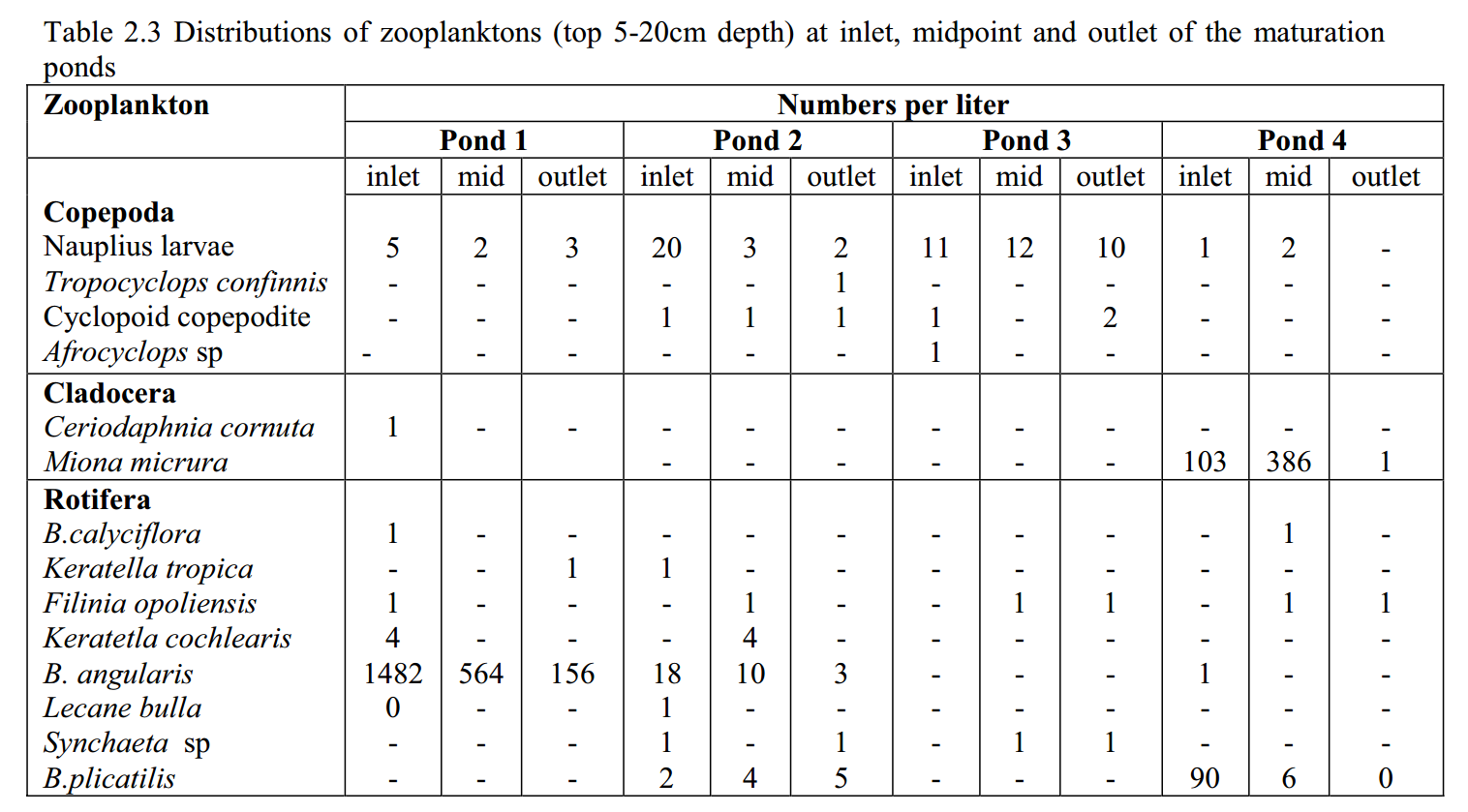
I think these numbers seem comparable to typical zooplankton densities in lakes (Tomasik "Zooplankton Densities ...").
Here are biomass numbers (p. 33):
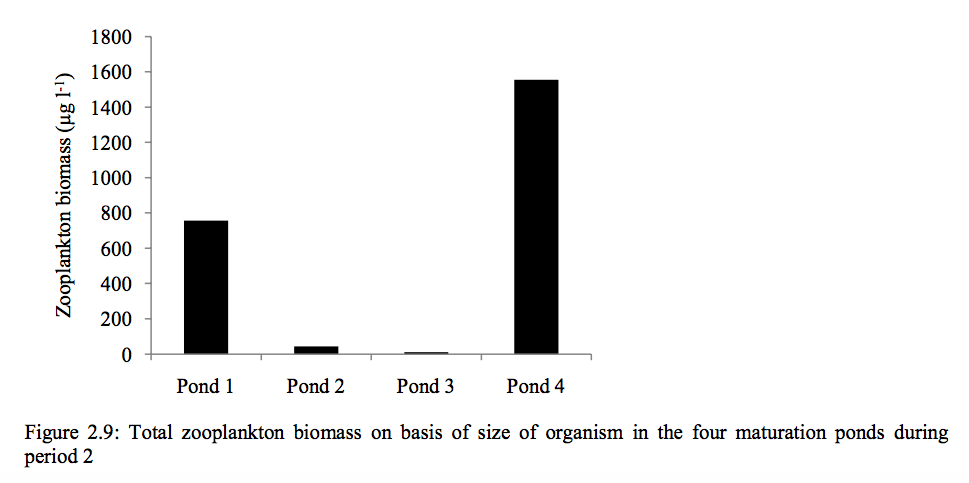
Even though Pond 1 had the most total zooplankton by numbers, Pond 4 had higher biomass because the cladocerans that were abundant in Pond 4 were bigger than the rotifers that were abundant in Pond 1 (p. 32).
The zooplankton "were sampled during day time using a one liter plastic container" (p. 27). Babu (2011) notes (pp. 31-32):
Midge larvae (blood worms) of Chironomidae were present and were seen attached on the biofilms. However they were not enumerated; only micro invertebrates in the water column were counted. From table 2.3 [the table I copied above], it was seen that copepods and cladocera were either low in numbers or absent. The crustacean zooplanktons exhibit diurnal migrations moving to the water surface at night and to the bottom during day. The copepods can detect and avoid mechanical shock [...], it is possible that most crustacean zooplanktons detected mechanical disturbance by the sampler and eluded being sampled.
Duckweed cover
Note: I haven't looked into the issue discussed in this subsection. I include it only as a starting point for further investigation.
In his "Introduction", Babu (2011) mentions (p. 5):
Schumacher and Sekoulov (2002) observed increased pond pH by algal biofilms (due to consumption of carbon dioxide by the photosynthesis). The resulting high pH values caused a decrease in nitrogen removal [...]. This is an indication that probably the process of denitrification was affected; which was to the disadvantage of the treatment process. Previous studies (Caicedo et al., 2005) have shown that combination of algae and duckweed systems can counteract the effect of high pH. In duckweed ponds, light penetration is limited hence algal productivity is virtually absent. Stable pH of 6.8 to 7.0 and relatively low oxygen levels has been reported in these ponds.
In other words, duckweed's limitation on algal productivity may serve the function of avoiding high pH. Limiting algal productivity is also good with respect to the goal of reducing future heterotroph populations, since less algae probably means fewer animals eating that algae. However, I worry that the duckweed itself might be highly productive, in which case the duckweed cover wouldn't actually reduce total productivity? Cross (1994) says of duckweed: "[Some authors] summarize many earlier studies demonstrating the unusually high productivity of this aquatic plant. Dry weight increases of 10-20 tons/ha/yr are the norm." I wonder if this depends on whether the duckweed is harvested or not??
Nandini (1999)
Nandini (1999) examined stabilization ponds in India. The ponds looked like the following, with raw sewage coming in at the top and cleaned water going out at the bottom.
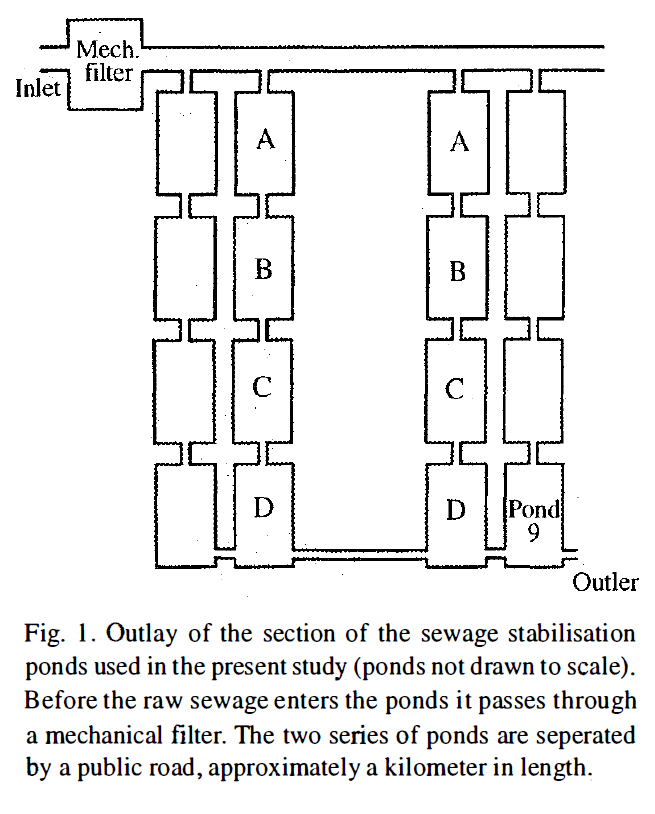
Nandini (1999) found the following densities of copepods and cladocerans (Fig. 7) and rotifers (Fig. 8):
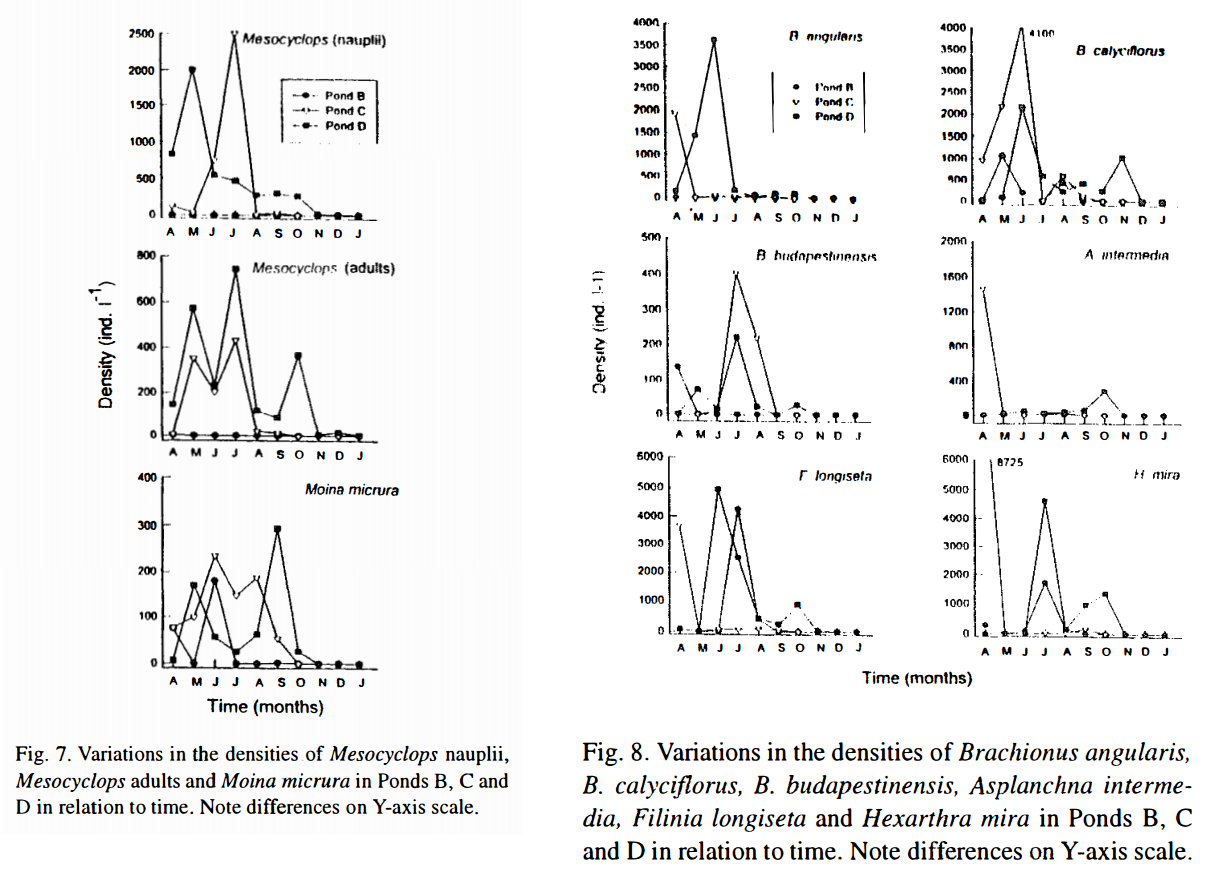
I think some of these densities are pretty high relative to typical zooplankton densities in lakes (Tomasik "Zooplankton Densities ...").
Nandini (1999) mentions in the "Discussion" (p. 154):
Bacterial load in sewage stabilization ponds can be very high and to a large ext[e]nt this is controlled by the development of high densities of ciliated protozoans and flagellates (Curds and Fey 1969; Rivera et al. 1986, 1987; Madoni 1991; Vaqué and Pace 1992). Zooplankton, particularly cladocerans and rotifers are also known to feed efficiently on bacteria (Vaqué and Pace 1992, Starkweather et al. 1979). In this study too, the highest densities among rotifers were reached by Hexarthra mira and Filinia longiseta which are predominantly bacterivores (Koste 1978). In studies done elsewhere in Asia (Green and Lan 1974) on sewage-stabilization ponds, bacterivorous species such as Brachionus calyciflorus, Hexarthra mira, Filinia longiseta and Epiphanes macrourus form the bulk of the rotifer fauna. Therefore, even in the absence of edible green algae, high densities of zooplankton can be maintained due to the high bacterial load (Uhlmann 1980).
I'm not an expert, but I read the above passage as saying that the zooplankton in the stabilization ponds were not purely feeding on newly growing algae but were also eating bacteria that had fed on organic matter in the sewage itself? That is, some fraction of the zooplankton production came from the sewage's organic matter? Anyway, this distinction may not be hugely important, because ultimately what determines zooplankton suffering is the total zooplankton population that stabilization ponds support, whether feeding on wastewater bacteria or newly growing algae. But this point helps to clarify whether stabilization ponds have zooplankton only because they're (nutrient-rich) ponds or also because they get extra organic matter as input.
Comparison with activated sludge
While I don't have specific numbers, it seems based on the qualitative information I've read that invertebrate animals are generally more abundant in lagoons and stabilization ponds than in activated-sludge systems, at least per unit of organic matter respired. Partly I assume this because slower systems allow more time for more complex heterotrophs to grow and reproduce. Does this mean that using activated-sludge systems instead of lagoons or ponds reduces the world's total invertebrate population? It's not clear, because lagoons and ponds cover a larger area than activated-sludge plants and so displace more terrestrial invertebrates. The full comparison is between
- invertebrates created in activated-sludge systems + invertebrates on the remaining land that doesn't need to be covered by a lagoon or pond, versus
- invertebrates created by lagoons or ponds (eating organic matter in the influent waste and eating algae growing in the water).
It's not obvious which of these totals is larger without specific data.
Other information
Summers (2014) says "I once operated a sewer plant", though he doesn't specify what kind. He says that sometimes effluent can contain high numbers of rotifers, but this is a bad sign because it suggests "there is entirely too high a level of solids. This means too much too many [sic] 'nutrients' are being released back into the ecosystem, perhaps a stream."
Wikipedia ("Treatment pond") says of treatment ponds: "Several types of invertebrates are present in the ponds where they maintain algae levels and help allow the sediment to settle on the bottom. With mosquitos being a problem for those who maintain the ponds the addition of mosquito fish and several other types of predatory fish is good in order to keep the bugs in check. They are primarily used for mosquito control as treatment ponds are fantastic breeding grounds for mosquitos."
Nandini et al. (2004)
Nandini et al. (2004) examined "The population growth patterns of four cladocerans, viz. Alona rectangula, Ceriodaphnia dubia, Moina macrocopa and Daphnia pulex on wastewaters from a treatment plant at Iztacalco, Mexico City" (p. 59). One of the goals was to evaluate the potential of these crustaceans "in aquaculture as first feeds for fish larvae" (p. 64), so the authors were hoping to see large populations. The authors tried growing the cladocerans in four different tanks:
- Control tank containing Chlorella vulgaris, a "unicellular green alga" (p. 60).
- Tank A—"crude wastewater": "Wastewater from tank A is the crude form where large floating organic matter is allowed to precipitate" (p. 60).
- Tank B—"partially treated wastewater": "In tank B, the organic matter is allowed to decompose and is partially treated using continuous aeration and water circulation" (p. 60).
- Tank C—"treated wastewater, but not chlorinated": "Tank C is the last, but one stage before the water is pumped for industrial purposes such as car wash centres" (p. 60).
The cladoceran populations typically grew and then, "on reaching the carrying capacity, began to decline" (p. 60). Following are peak abundances of the cladocerans, in individuals per milliliter (not individuals per liter):
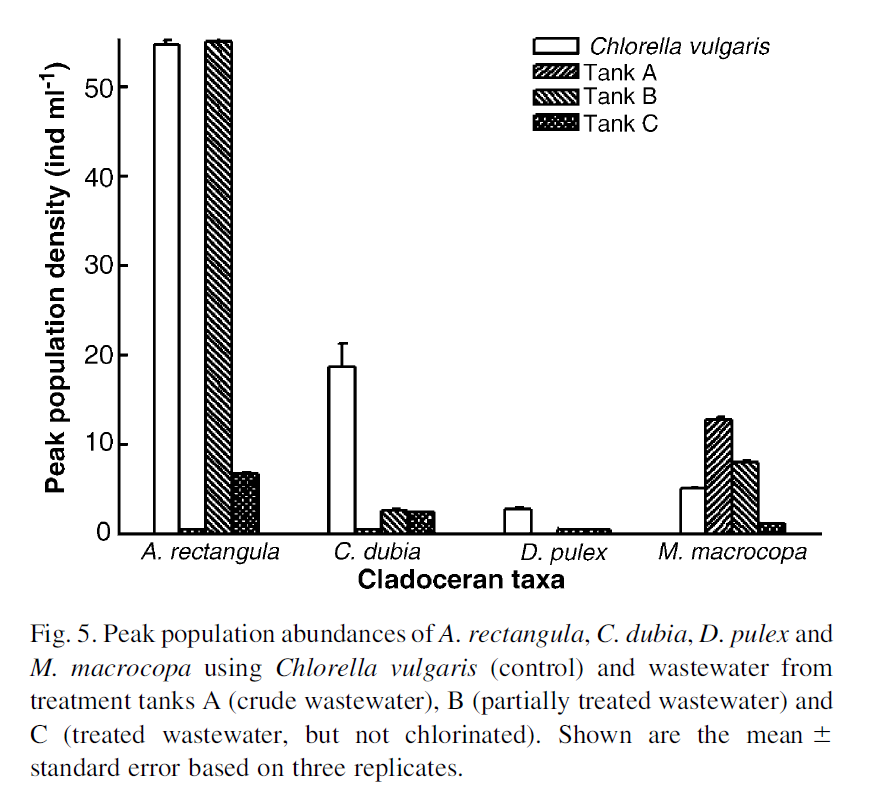
Some of these densities are extraordinarily high relative to typical cladoceran densities in lakes (Tomasik "Zooplankton Densities ...").
The total number of cladocerans born was presumably a bit higher than these peak abundances because there were some deaths before peak abundances were reached ("Dead individuals when encountered were eliminated", p. 60) and also, I would guess, some births after peak abundances were reached.
Eutrophication
Wikipedia ("Sewage"): "Sewage contains nutrients that may cause eutrophication of receiving water bodies".
Wikipedia ("Sewage treatment"):
A phytoplankton study found high nutrient concentrations linked to sewage effluents. High nutrient concentration leads to high chlorophyll a concentrations, which is a proxy for primary production in marine environments. High primary production means high phytoplankton populations and most likely high zooplankton populations, because zooplankton feed on phytoplankton. However, effluent released into marine systems also leads to greater population instability.
Leibenluft (2008): "There is evidence that the [sewage-treatment] effluent that is pumped back into local water streams does affect their chemical composition and aquatic life." This is probably bad if an increase of nutrients augments algae growth somewhat but doesn't make the water anoxic. The net impact is less clear if eutrophication is so severe as to cause anoxia, since in that case, less decomposition will be done by metazoa, although more food will be available to be eaten in total. I assume that it's rare in Western countries for sewage-treatment effluent to cause complete anoxia in receiving waters??
BWB (2014) reports that Berlin wastewater is treated so as to reduce nutrient loads in output water (p. 25): "97 % of the phosphates in wastewater can be removed."
Diggelman and Ham (2003) report that the Madison Metropolitan Sewerage District wastewater treatment plant in Madison, Wisconsin, USA "provides tertiary treatment of wastewater", including "denitrification and phosphorus removal" (p. 507).
Lundie and Peters (2005)
Lundie and Peters (2005) examined different methods for disposing of food waste in terms of various environmental-impact metrics. Using a garbage disposal unit was found to contribute to about 3 times as much "eutrophication potential" as disposing of food in landfills (Table 3, p. 284). That said, relative to all the ways in which people contribute to eutrophication, using a garbage disposal unit constituted only 2.1% of the total (Table 4, p. 284). Simmons (2014) summarized the finding in this way: "sink disposals were responsible for about 2.1 percent of nutrient overload in the water—a much higher percentage than landfill trash and composting—but relatively quite minor compared with nonpoint source pollution, aka runoff from farms and fertilizer-spiked stormwater".
It's worth noting some distinctive features of the location in Australia that Lundie and Peters (2005) studied. The authors explain that eutrophication potential "is controlled by the ability of the sewage treatment plant to remove nutrients from suspension and from the aqueous phase of sewage. Bondi sewage treatment plant (STP) is a 'high rate primary' plant, so approximately 50% of the influent nitrogen and phosphorous are released in the treated effluent" (p. 281).f On the other hand: "in Waverley Council area, the treated effluent is released below a density stratification layer ('pycnocline') in the Tasman Sea. This generally prevents it from contact with sunlight, and the risk of eutrophication endpoints is low" (p. 283). That said, even if released nutrients initially are below the euphotic zone, maybe they'll eventually migrate upward and stimulate phytoplankton later??
Food waste vs. generic sewage
Diggelman and Ham (2003) note "that wastewater systems are carbon limited systems. Adding food waste carbon to a carbon limited wastewater system contributes to a net removal of nutrients (nitrogen and phosphorus) from effluent, if nutrients are assimilated with carbon into biomass and removed from the system as sludge" (p. 512). If this effect is significant, I wonder if disposal of food waste down the drain actually reduces eutrophication, even if flushing urine and feces down the toilet increases eutrophication?
Organic-waste discharges
Lundie and Peters (2005) explain regarding the Bondi Sewage Treatment Plant (pp. 277-78): "Treated wastewater is discharged to the marine aquatic environment. This wastewater contains some of the organic matter from" food scraps ground up by garbage disposal units.
My reading of the following passage from Stevens et al. (1985), p. 24, is that discharges from wastewater plants may contain some organic material that can contribute to zooplankton growth:
An alternative hypothesis to explain the reduced plankton populations was offered by Striped Bass Working Group member Charles Hanson. Inorganic nutrient concentrations have not fallen, but Hanson hypothesized that improved waste treatment at point-source discharges in the estuary during the first half of the 1970s has reduced the contribution of organic material to the system and may have contributed to a decline in the productivity of Suisun Bay and the [Sacramento-San Joaquin] delta, particularly in the production of microorganisms that are eaten by zooplankton. The abundance of zooplankton at the times and places where larval striped bass are concentrated is well correlated with Hanson's index of organic loading based on biochemical oxygen demand (BOD) data from six point-source discharges in Suisun Bay and the western delta [... see the figure I copied below]. [...]
These results suggest that changes in waste treatment may have contributed to reduced production of zooplankton and striped bass in the estuary and may be important in the striped bass decline. The Striped Bass Working Group concluded that this hypothesis is worthy of more detailed examination. That examination will require more careful assessment of organic input to the system from all sources, probably based on some measure other than BOD. Use of BOD as a measure of the value of organic detritus as an energy source to the ecosystem probably exaggerates the contribution of wastewater discharge.
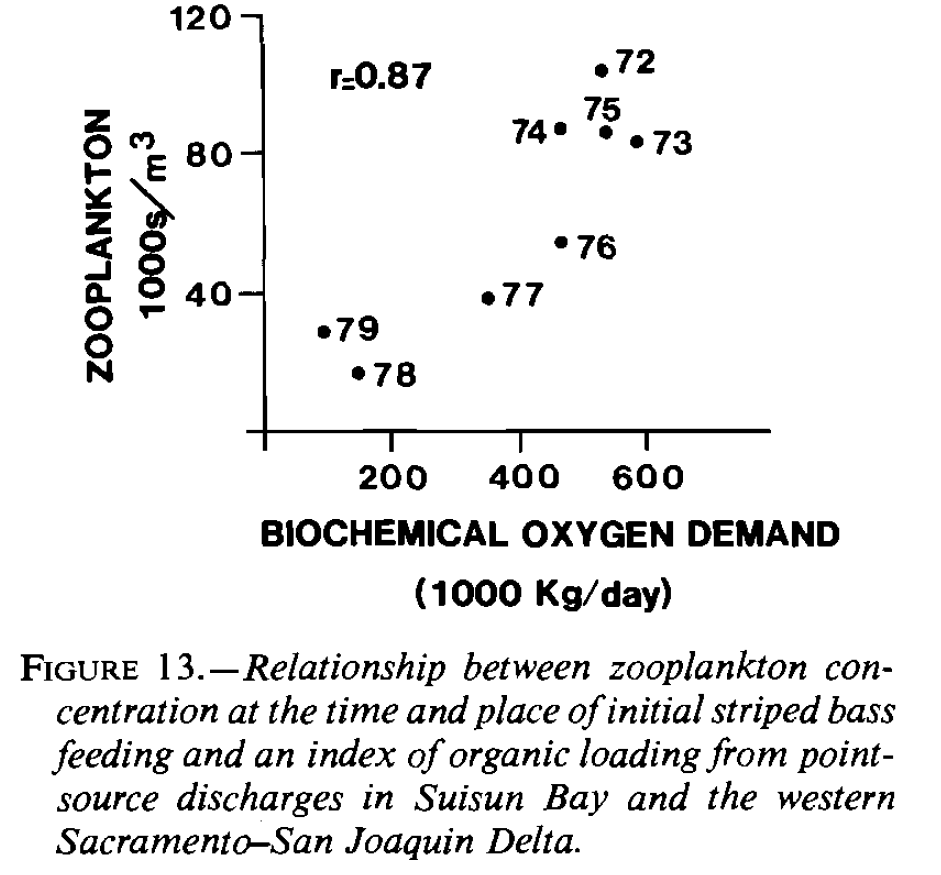
Note that 1000s per m3 is the same as number per liter.
Sewage sludge
While some of the organic matter in sewage is eaten and respired during secondary treatment or when released to a receiving water body, the rest of the organic matter in sewage ends up as sludge that falls to the bottom of tanks in the treatment system.
Secondary-treatment sludge contains microorganisms of various sorts. For example, Glymph (2013) shows (p. 2) that "Mixed liquor is pumped to secondary clarifiers where biological solids, containing microorganisms is separated from the liquid." From there, "Some secondary solids are wasted to solids handling/processing." I assume that this sludge can contain animals as well as bacteria?
Quantities
The total sludge production from a wastewater treatment process is the sum of sludge from primary settling tanks (if they are part of the process configuration) plus excess sludge from the biological treatment step. For example, primary sedimentation produces about 110–170 kg/ML [kilograms per megaliter] of so-called primary sludge, with a value of 150 kg/ML regarded as being typical for municipal wastewater in the U.S. or Europe. [...] Of the biological treatment processes, the activated sludge process produces about 70–100 kg/ML of waste activated sludge, and a trickling filter process produces slightly less sludge from the biological part of the process: 60–100 kg/ML. This means that the total sludge production of an activated sludge process that uses primary sedimentation tanks is in the range of 180–270 kg/ML, being the sum of primary sludge and waste activated sludge.
Wikipedia ("Sewage sludge") also says: "When fresh sewage or wastewater enters a primary settling tank, approximately 50% of the suspended solid matter will settle out in an hour and a half." But in addition to suspended organic matter, wastewater contains dissolved organic matter, whose removal is the goal of secondary treatment (Malik 2014).g I wonder what fraction of all organic matter is suspended vs. dissolved?
Albany County Sewer District (2016): "Primary treatment removes approximately 25-35% of the biochemical oxygen demand (BOD) in wastewater and 40-60% of the suspended solids in the wastewater" (p. 7). BOD is a measure of microbe-edible organic matter. The average of "25-35%" is 30%, so let's assume that's how much BOD is removed by primary treatment. Then, secondary treatment "uses microorganisms to remove 85-95% of the remaining suspended solids and BOD prior to discharge to the Hudson River" (p. 8). Let's assume secondary treatment removes 90% of the remaining BOD. The remaining BOD is (100%-30%) = 70% of the starting amount, so secondary treatment removes roughly 90% * 70% = 63% of the starting amount of BOD. I wonder what fraction of this BOD removal is due to respiration during secondary treatment and what fraction is removed as secondary sludge.
ClearCove (2014) reports: "Primary sludge contains higher biogas production potential because it was captured via gravity and therefor[e] its energy content has not yet been consumed. Secondary sludge has lower biogas potential because the microorganisms in the secondary treatment process have consumed most of their energy content leaving behind mainly inert biomass."
Sludge treatment
Wikipedia ("Sewage sludge treatment") describes main ways in which sewage sludge can be treated, including digestion (anaerobic or aerobic), composting, and incineration. If I had to guess at the numbers of invertebrate animals involved in these different treatment methods, I would presume that composting has the most, followed by aerobic digestion, and there are probably very few invertebrates in either anaerobic digestion or incineration. However, I know little about these processes, so my conjectured ranking could be wrong.
Insofar as we also want to reduce bacteria populations in addition to invertebrate-animal populations, incineration seems best because it releases the energy the sludge contains in a non-sentient way, while digesting or composting sludge creates large numbers of bacteria. A downside of incineration is that, if sludge contains invertebrates (does it?), incinerating to death may be painful for those animals. The idea that heating to death may be painful for nematodes is not purely speculation, since "upon exposure to noxious temperature, Caenorhabditis elegans reacts by a withdrawal reflex. [...] the nociceptive response of C. elegans to heat resembles, in several aspects, that of higher organisms" (Wittenburg and Baumeister 1999).
In any event, Wikipedia ("Sewage sludge treatment") says "Incineration of sludge is less common because of air emissions concerns and the supplemental fuel (typically natural gas or fuel oil) required to burn the low calorific value sludge and vaporize residual water." That said, for example, Albany County Sewer District (2016) reports that their sludge is "dewatered and incinerated" (p. 8). Albany County Sewer District (2016) explains: "The cake formed by the dewatered sludge on the belt filter press is next incinerated in a multiple hearth incinerator. The resulting ash from the incineration process is then stored in lagoons prior to ultimate disposal at a landfill site" (p. 15).h
Based on a priori speculation, I would guess that anaerobic digestion of a given quantity of sludge supports fewer bacteria than aerobic digestion does because I think anaerobic digestion extracts less biologically useful energy from the sludge. One way to see this is that anaerobic digestion produces methane gas, which can be burned into CO2, while aerobic digestion produces CO2 directly. The energy generated from combusting methane biogas isn't powering bacteria.
I don't know whether sludge composting brings into existence multicellular animals in addition to bacteria, but I would guess it does, since most forms of aerobic composting involve some invertebrates. Wikipedia ("Sewage sludge treatment") says regarding composting: "Composting is an aerobic process of mixing sewage sludge with agricultural byproduct sources of carbon such as sawdust, straw or wood chips. In the presence of oxygen, bacteria digesting both the sewage sludge and the plant material generate heat to kill disease-causing microorganisms and parasites." Presumably the pathogen-killing heat at least temporarily reduces invertebrate numbers in the compost piles?
Wikipedia ("Sewage sludge treatment") also describes the technique of "drying beds", which "are used in many countries, particularly in developing countries, as they are a cheap and simple method to dry sewage sludge." Especially given that these beds are "usually left uncovered", I would guess that invertebrates colonize them?
Wikipedia ("Sewage sludge treatment") explains regarding choice of sludge-treatment method: "Air-drying and composting may be attractive to rural communities, while limited land availability may make aerobic digestion and mechanical dewatering preferable for cities, and economies of scale may encourage energy recovery alternatives in metropolitan areas."
Wikipedia ("Vermicompost") reports that "Vermicomposting can also be applied for treatment of sewage sludge." This seems bad because worm composting gives rise to lots of invertebrates, given that the process is aerobic and occurs at worm-tolerable temperatures. My uninformed impression is that vermicomposting of sewage sludge isn't very common.
Lotzof (n.d.)
Lotzof (n.d.) discusses "The use of vermiculture as a method for the stabilisation of sewage sludge and other organic wastes" and says: "Notwithstanding the scientific support for the process, vermiculture has remained a cottage industry, with very few large scale facilities processing substantial quantifies of organic waste."
Lotzof, who is affiliated with the company Vermitech Pty Limited, explains:
Vermitech has, through the development of proprietary equipment and processes, created a system that can consistently and cost effectively, stabilise a large range of organic wastes including sewage sludge. [...]
Sludge from a broad spectrum of sewage and water treatment plants is being stabilised and the end product sold. Dewatered sludge is taken directly from the treatment plant and fed to the worms without the need for any pre composting or aging.
Systems have been installed on a number of sites, the largest being a 400m3/week capacity facility at Redland in Brisbane Queensland[, Australia].
Disposal of 400 m3 per week is 400/7 ≈ 60 m3 per day. Lotzof (n.d.) explains that "It is [...] essential that the quantity fed match the daily quantity consumed by the worms." So presumably the worms collectively consume about 60 m3 per day? Lotzof (n.d.) also says: "Worms eat between one half and their own body weight per day. On this basis, the Redland site will contain between 80 and 160 tonne of worm biomass." So eating 60 m3 per day seems to imply eating ~80 tonnes per day. This would make sense if the input sludge is slightly more dense than water, which has a density of 1 kg per L = 1 tonne per m3.
On the web, I've seen estimates of an earthworm's mass as on the order of a gram, maybe a bit higher or lower. For example, Worms Etc (2013) says that Eisenia hortensis worms "average about 1.5 gram per worm (.05 ounce), but can weigh as much as 7 grams each (1/4 ounce)." Assuming ~1 gram per worm (including juveniles), ~80 tonnes of worm biomass would be ~80 million worms.
Sludge disposal
Wikipedia ("Sewage treatment") says: "Dewatered sludge may be incinerated or transported offsite for disposal in a landfill or use as an agricultural soil amendment."
Applying treated sludge (aka "biosolids") to land seems slightly bad with respect to invertebrate suffering insofar as it increases plant productivity, although maybe artificial fertilizers would just be used if sludge weren't. Insofar as biosolids also contain undecomposed organic matter, they may feed bugs in the soil(?), which is also unfortunate. In contrast, decomposition in landfills may be mostly done by bacteria due to anaerobic conditions?
Wikipedia ("Sewage sludge") explains: "Following treatment, sewage sludge is either landfilled, incinerated, applied on agricultural land or, in some cases, retailed or given away for free to the general public." Wikipedia ("Sewage sludge") also says regarding the USA: "As of 2004, about 60% of all sewage sludge was applied to land as a soil amendment and fertilizer for growing crops." Huler (2010) says "nationwide about 50 percent of sludge is reused" as biosolids, but "Plenty of cities still landfill their sludge." NPR (2013): "In the U.S., about 55 percent of the sewage sludge that's produced at wastewater treatment plants is recycled as biosolids." However, a lot of sludge "still ends up in landfills or being processed at big, industrial incinerators".
Footnotes
- Wikipedia ("Anaerobic organism"): "Except for three species of anaerobic loricifera, all known complex multicellular life is aerobic, i.e. needs oxygen to survive." (back)
- That said, Glymph (2005) says that "Metazoa are larger than most protozoa" (p. 65). And Theobald (2014): "Metazoa [...] are larger than most protozoa".
Maine Lagoon Task Force (2003) says that protozoa tend to be 0.01 to 0.2 mm in size. (back)
- For simplicity, I'm ignoring actinomycetes, which are also bacteria. Including them would only ~double bacterial biomass. (back)
- I would guess that a home composting bin provides a more stable, long-term environment for food decomposition than exists in wastewater treatment, which may be part of the reason why compost bins can support bigger organisms, like earthworms?
Madoni (2010), p. 3: "of all the heterotrophic organisms only protozoa and small metazoa with life cycles shorter than the sludge retention time are able to compete in these [biological wastewater treatment] processes." (back)
- I can't quite figure out how this number was calculated based on the input numbers given on p. 507 of Diggelman and Ham (2003), but let's go with it anyway. (back)
- Do most sewage-treatment plants filter out more nutrients than this? If so, would eutrophication potential be lower in most other cases? (back)
- In fact, Glymph (2013) says (p. 33): "Bacteria can only consume soluble organic material. Insoluble organics or particulates must be converted to soluble form before they can be consumed by the bacteria." (back)
- Since the belt filter press comes before incineration (Albany County Sewer District 2016, Figure 2, p. 17), I wonder if any invertebrates present in the sludge get crushed there prior to being burned? (back)